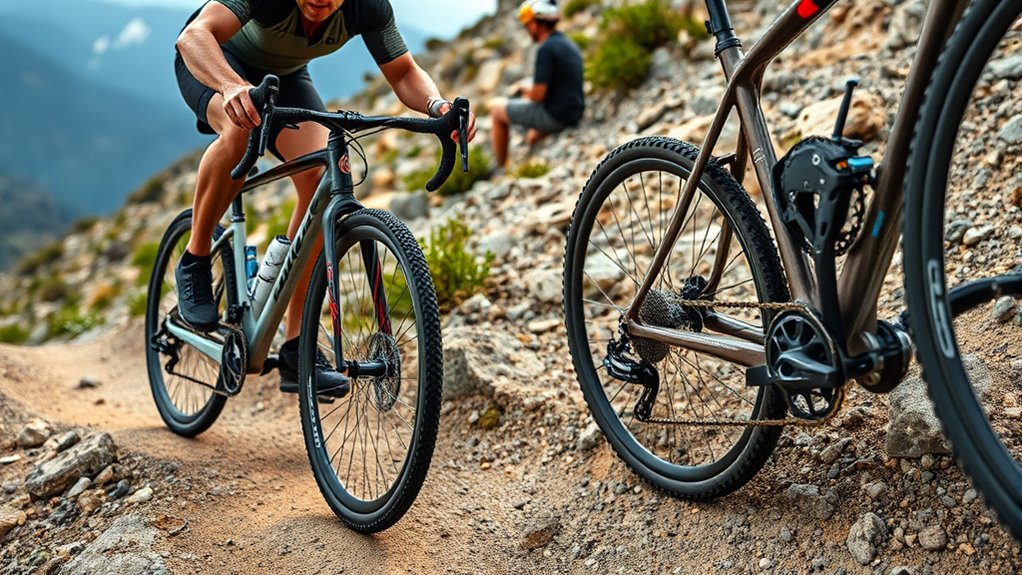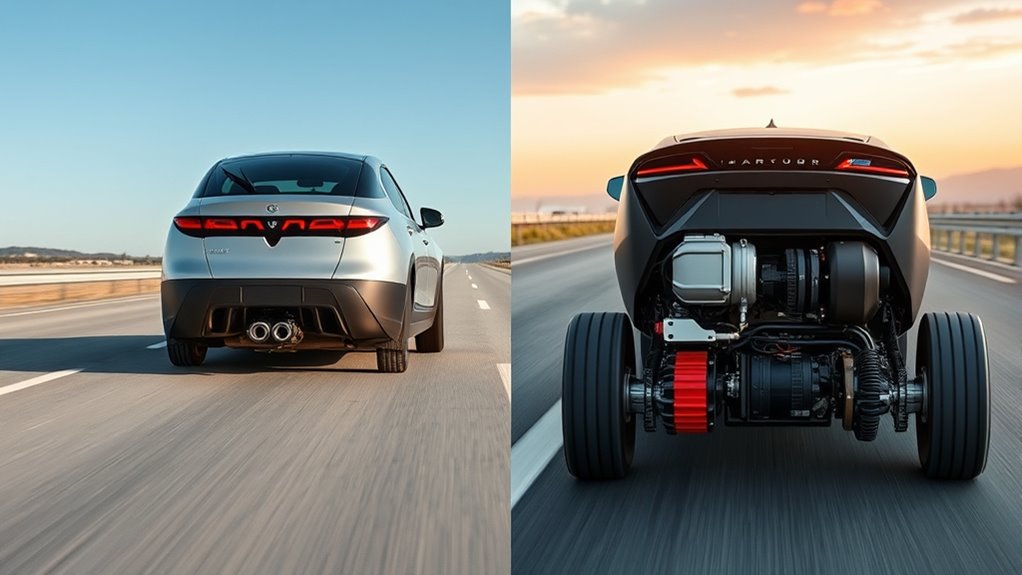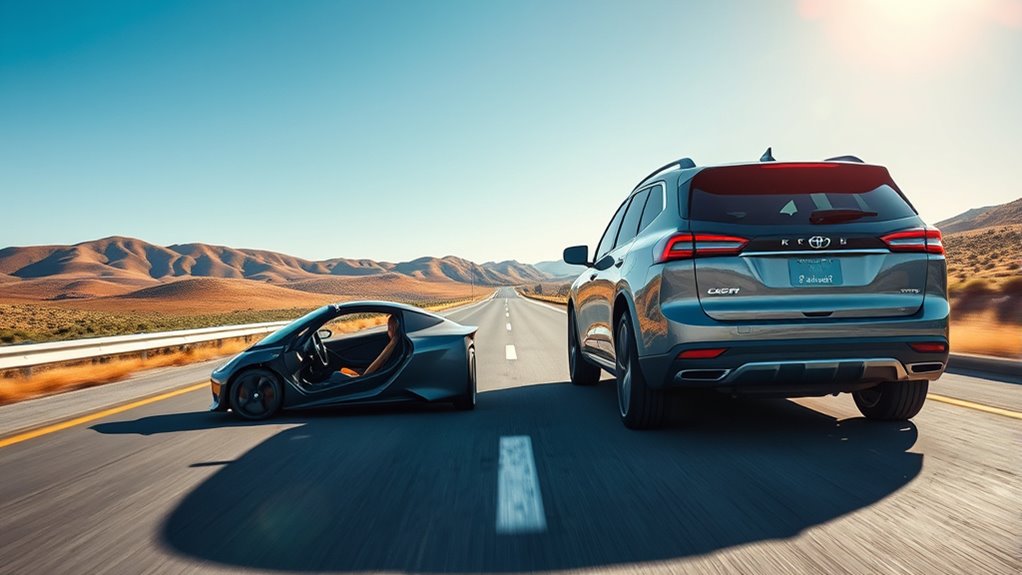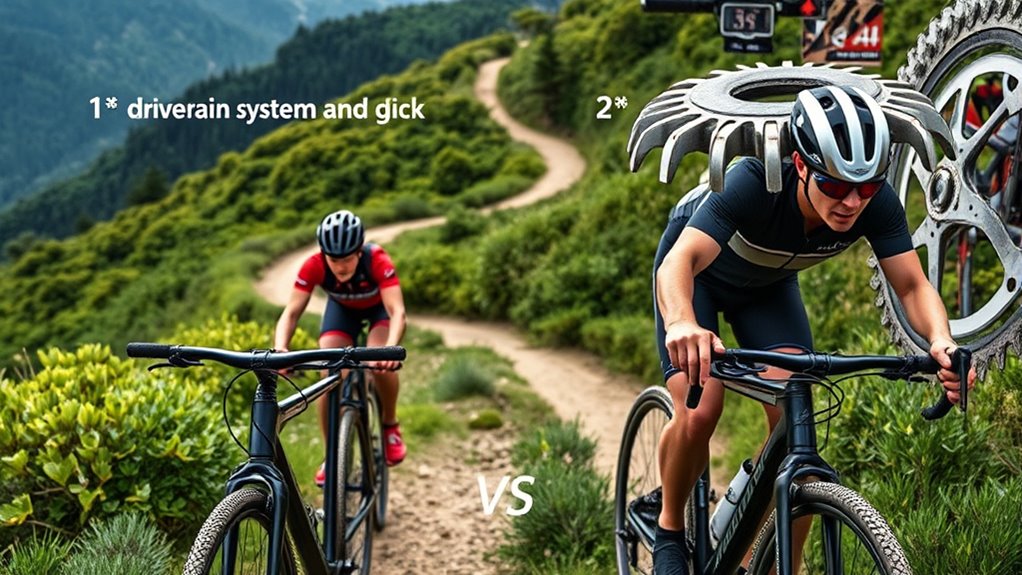Choosing between 1× and 2× drivetrains on the road depends on your priorities. A 1× setup offers simplified shifting, fewer parts, and less maintenance, making it reliable and straightforward, especially on varied terrain. However, it has fewer gear options and larger jumps between gears. A 2× system provides more precise control with a broader gear range, ideal for climbing and descending. To get a clear picture of which suits your riding style, explore more details below.
Key Takeaways
- 2× drivetrains offer more gear options with finer steps, providing smoother shifts and better cadence control on varied terrains.
- 1× systems simplify setup and maintenance by removing front derailleurs, reducing weight and mechanical complexity.
- 2× setups provide narrower gear ranges with more overlapping gears, advantageous for precise cadence and versatile riding.
- 1× drivetrains use wide-range cassettes to achieve similar ranges with fewer gears, but can result in larger gear jumps.
- Industry trends favor 1× for its simplicity and reliability, though 2× remains preferred for optimal gear selection and smoother shifting.
Understanding the Basics of 1× and 2× Drivetrains

Understanding the basics of 1× and 2× drivetrains starts with their key structural differences. A 1× drivetrain uses a single gear and a wide-range rear cassette, eliminating the need for a front derailleur. This design simplifies shifting and reduces weight, with gear ratios spanning from small to large cogs for a broad gear range. In contrast, a 2× drivetrain features two front chainrings and a front derailleur, giving you more gear options and smaller gear steps for smoother cadence. The front derailleur moves the chain between the chainrings, allowing for fine-tuned gearing adjustments. While 2× systems offer more precise gear ratios, 1× setups rely on a single gear to provide a straightforward, reliable shifting experience, especially on diverse terrains. Additionally, the choice between 1× and 2× drivetrains depends on rider preference and riding style, with drivetrain configuration affecting overall performance. Understanding the gear ratio and how it influences cadence and effort is essential for selecting the best system for your riding needs. Advances in drivetrain technology continue to improve shifting accuracy and durability across both systems. Incorporating user-friendly design features has also contributed to the widespread adoption of 1× drivetrains among different rider demographics. Furthermore, gear shifting mechanisms have become more intuitive, making it easier for riders to adapt to new systems and terrain changes.
Key Advantages of 1× Drivetrains for Road Cycling

With a 1x drivetrain, shifting becomes simpler and more reliable, making your rides smoother and less frustrating. Fewer parts mean less maintenance and fewer chances for mechanical issues, so you can focus on riding. Plus, the gear range is often sufficient for most road cycling needs, providing enough options without the complexity of a double setup. Additionally, formal training can be beneficial for optimizing your bike’s setup and maintenance.
Simplified Shifting Process
One of the main advantages of 1× drivetrains is how they simplify shifting by removing the front derailleur and shifter, leaving you to control only the rear derailleur. This makes the gear choices straightforward and reduces the mental load during rides. With simplified shifting, you don’t have to worry about front derailleur adjustments or cross-chaining issues. Instead, you focus on managing a single shifter, which streamlines gear changes and speeds up your response time. Fewer components also mean fewer chances of mechanical failures, like dropped chains or derailleur problems. This setup allows for quicker, more intuitive shifts, helping you stay focused on riding rather than adjusting gears. Overall, the simplified shifting process enhances confidence and efficiency on the road. Additionally, gear ratios in 1× setups are often optimized for a wide range of terrains, providing sufficient cadence options without the need for multiple chainrings. Modern gear shifting technology further improves the ease and reliability of gear changes, making 1× drivetrains an increasingly popular choice among cyclists.
Reduced Mechanical Parts
A key advantage of 1× drivetrains is their reduced number of mechanical parts, which simplifies maintenance and boosts reliability. By eliminating the front derailleur and the two chainrings, you have fewer parts to worry about and less drivetrain complexity. This results in fewer pivot points and linkages, making setup and adjustments easier. Additionally, with fewer parts, the system is less prone to issues caused by mud, dirt, or debris, especially in challenging conditions. The simplified design also cuts weight—saving around 165 grams in some setups—enhancing performance. Overall, fewer parts lead to a more durable, lower-maintenance drivetrain that performs reliably across diverse riding conditions. Moreover, Hyundai Tuning demonstrates how streamlined systems can improve overall vehicle efficiency and longevity. Incorporating simplified drivetrain designs can also reduce the need for frequent repairs, further increasing reliability and rider confidence. Furthermore, adopting a minimalist setup can streamline your riding experience, making gear changes smoother and more predictable, and can contribute to the overall efficiency of your bike system.
Adequate Gear Range
By removing the front derailleur and multiple chainrings, 1× drivetrains simplify your bike’s setup, but that doesn’t mean sacrificing gear range. Modern 1× systems provide a wide range of gears through large cassette sprockets, like 10-52t or 11-34t, offering adequate gears for various terrains. This setup delivers low gears for steep climbs and high gears for fast descents, matching the versatility of 2x systems. The absence of extra components reduces weight and maintenance while maintaining a thorough gear range. With carefully selected cassette sizes, you get enough overlap and coverage to handle most road cycling scenarios. In essence, 1× drivetrains offer an efficient, simplified solution without compromising on the adequate gears needed for diverse riding conditions.
Limitations and Challenges of 1× Setups

While 1× drivetrains simplify your setup, they come with notable limitations. You may find the gear range narrower, and the larger jumps between gears can make it harder to maintain a smooth cadence. Additionally, you might face increased maintenance needs due to compatibility issues and the heavier components required. Moreover, the gear ratio options are limited compared to 2× setups, which can restrict your riding versatility.
Limited Gear Range
Limited gear range in 1× drivetrains can make it challenging to find the right cadence or power output across diverse terrains. With fewer gears—usually around 12—you have a limited gear ratio range, which can restrict your ability to smoothly adapt. The larger sprockets in 1× cassettes create bigger jumps—often 10-12 teeth—making seamless shifts difficult. This restricted gear range can hinder your efficiency on steep climbs or rapid descents, especially on hilly terrain. To compensate, 1× systems often rely on very wide-range cassettes, but this adds weight and complexity. Overall, the limited gears restrict your ability to maintain an ideal cadence, forcing you into less suitable power outputs and making it harder to adapt quickly to changing terrain.
Larger Gear Jumps
Have you noticed that shifting between gears in a 1× drivetrain can sometimes feel abrupt or jarring? That’s because of the larger gear jumps inherent in 1x drivetrains. These systems use bigger cassette sprockets, often with 8-10 teeth between gears, which creates noticeable changes in gear ratios. This makes it harder to maintain a consistent cadence, especially on varied terrain. The absence of smaller intermediate gears limits fine-tuning, forcing you into bigger jumps that can disrupt your pedaling flow. Larger gear jumps can also cause cross-chaining at extreme gears, increasing wear and reducing efficiency. To manage this, 1x setups rely on wider-range cassettes like 10-52T, but these add weight and cost, highlighting a key challenge of 1× drivetrains. Additionally, the gear ratio range can influence how well the drivetrain adapts to different riding conditions, impacting overall performance.
Compatibility and Maintenance
Converting a bike to a belt drive or upgrading a 1× drivetrain can be challenging because of compatibility issues. First, belt drives require specific frame modifications, like splitting the frame or installing eccentric bottom brackets, limiting compatibility with many bikes. Second, 1× systems often need larger, heavier cassettes (e.g., 10-52T), which can negate weight savings and complicate maintenance. Third, high gear ratios in 1× setups may require stronger derailleur components, reducing durability and chain retention. These factors make future upgrades or repairs more difficult. Additionally, since 1× setups lack a front derailleur and multiple chainring options, compatibility issues can arise over time, and maintenance becomes more complex, especially when dealing with chain tension and retention. It is also important to consider celery juice powder as a versatile ingredient that can influence the overall weight and balance of the bike when used in performance nutrition. Moreover, understanding drivetrain compatibility is essential for planning effective upgrades and ensuring smooth functionality.
The Benefits and Drawbacks of 2× Drivetrains

A 2× drivetrain provides cyclists with a greater number of gears—typically around 22—and finer gear ratio steps, giving you more versatility on varied terrain. This setup offers a wider gear range, making steep climbs easier and descents more controlled. The smaller gear jumps enable smoother shifting and maintain a steady cadence, especially during sustained efforts at high speeds. Additionally, the increased number of gear ratios means more mechanical complexity, with front derailleurs and multiple chainrings requiring more maintenance and potential points of failure. The extra weight can be a drawback for riders seeking a lightweight setup. Despite these drawbacks, many cyclists prefer 2× drivetrains for their precise gear selection and improved efficiency in demanding riding conditions. Recognizing the importance of attention to detail can help riders maintain optimal performance and prolong the lifespan of their drivetrain components.
Comparing Gearing Ranges and Overlap Between Systems

When comparing gearing ranges between 1× and 2× drivetrains, it’s important to recognize that 2× systems typically offer around 22 gears with smaller, more frequent gear ratios, while 1× setups usually feature 12 gears with larger jumps. This affects how you experience gear ratios and gear overlap: 1. 2× systems have more gear options, creating a narrower gear range with some overlap between chainrings, but many ratios are rarely used. 2. The maximum upward shift in a 2× setup is about 17 gears, reducing the need for frequent changes. 3. 1× systems, with wide-range cassettes (like 10-52T), achieve comparable or greater gear ranges, with fewer gears and larger jumps, thanks to larger sprockets. 4. Remote Gear Shifting systems are often used in 2× setups to improve shifting precision and convenience across multiple gears. Additionally, the integration of electronic shifting technology further enhances shift accuracy and reduces maintenance needs. Moreover, understanding how the gear overlap influences shifting comfort can help riders choose the most suitable system for their riding style. This comparison highlights how gear range and overlap differ between the two systems.
Industry Trends and Future Outlook for Drivetrain Technologies

Industry trends clearly show that 1x drivetrains are gaining popularity across various cycling disciplines, driven by their simplicity, lower maintenance, and technological advancements. Major manufacturers like SRAM, Shimano, and Campagnolo are expanding their 1x offerings, with many professional teams choosing 1x setups in races such as the Tour de France. Market analysis indicates a steady shift toward 1x systems, especially in endurance, gravel, and all-road cycling, with projections pointing to continued growth. Technological advancements, including improved wide-range cassettes and clutch derailleurs, are narrowing the gear gap between 1x and traditional 2x systems, increasing versatility. Industry experts anticipate that while 2x will remain for specialized applications, 1x drivetrains are poised to become the dominant standard for most road cycling disciplines.
Practical Performance in Real-World Cycling Scenarios

Modern 1x drivetrains deliver reliable performance across various cycling conditions, often matching or surpassing traditional 2x setups in real-world scenarios. They provide impressive terrain versatility with wide-range cassettes that cover most riding needs. Riders commonly experience:
Modern 1x drivetrains offer reliable, versatile performance with simplified setup and maintenance across diverse cycling conditions.
- Consistent shifting reliability, even in muddy or challenging conditions, reducing mechanical issues.
- Adequate gear range for varied terrain, making climbs and descents manageable without multiple front rings.
- Simplified setup and maintenance, contributing to smoother, more efficient rides.
While gear jumps are larger, optimized cassette sizes help maintain cadence control on steep inclines and sprints. Overall, 1x systems prove effective, balancing simplicity and performance in everyday cycling.
Factors to Consider When Choosing Between 1× and 2× Systems

Choosing between 1× and 2× drivetrains depends on several key factors that influence your riding experience. Your priority for gear range affects your choice—1x systems now offer wide ranges, like 10-52T cassettes, matching 2x setups, but often with larger gear jumps. If you prefer smoother gear steps for consistent cadence, 2x systems provide more precise gear control across varied terrain. Consider gear jumps too; 1x setups tend to have bigger jumps, which can feel abrupt, while 2x systems offer smaller, more manageable gear steps. Weight and simplicity also matter—1x drivetrains are lighter and less complex, ideal for minimalist setups. Ultimately, your riding style, terrain, and preference for gear precision will guide you toward the best system for your needs.
Frequently Asked Questions
Why Are 1x Drivetrains so Popular?
You’ll find 1x drivetrains popular because they’re simple and reliable, with fewer parts to worry about. They’re lighter, making your ride more efficient, and modern wide-range cassettes give you plenty of gears for any terrain. Shifting is easier, and the clean look appeals to your aesthetic preferences. Overall, they offer a hassle-free experience, making them a favorite among cyclists seeking performance and simplicity alike.
What Are the Disadvantages of a 1x Drivetrain?
You might wonder if a 1x drivetrain holds you back. The truth is, it can limit your gear options, making steep climbs tougher and shifting less smooth with larger gear jumps. You also face added weight from wider-range cassettes and derailleurs, which can offset the simplicity you gained. Plus, without enough gears, it’s harder to find that perfect cadence across all terrains, holding back your performance.
Is 1x or 2x Gravel Racing Better?
Choosing between 1x and 2x gravel racing depends on your riding style and terrain. If you prioritize simplicity, durability, and easier maintenance, a 1x setup might suit you better, especially for rougher courses. However, if you need precise gear control on hilly or technical terrain, a 2x drivetrain offers a wider, more refined range. Consider your course and preferences to make the best choice.
Which Is Better 2×11 Vs 1×11?
When choosing between 2×11 and 1×11, consider your riding style. A 2×11 gives you a wider gear range and finer control, which is great for varied terrain and climbs. It offers smoother shifts and smaller gear jumps, helping you maintain cadence. On the other hand, a 1×11 is simpler, lighter, and easier to operate, ideal if you prefer straightforward shifting and less maintenance. Your choice depends on your need for versatility versus simplicity.
Conclusion
As you ride along, the choice between 1× and 2× drivetrains feels like selecting the perfect gear for each stretch of road. Whether you prefer the simplicity of a single click or the versatility of two rings, remember that your decision shapes every mile. Sometimes, the road reveals surprises—just like gear ranges that unexpectedly match your needs. Trust your instinct, and let your drivetrain carry you smoothly through every twist and turn.
















